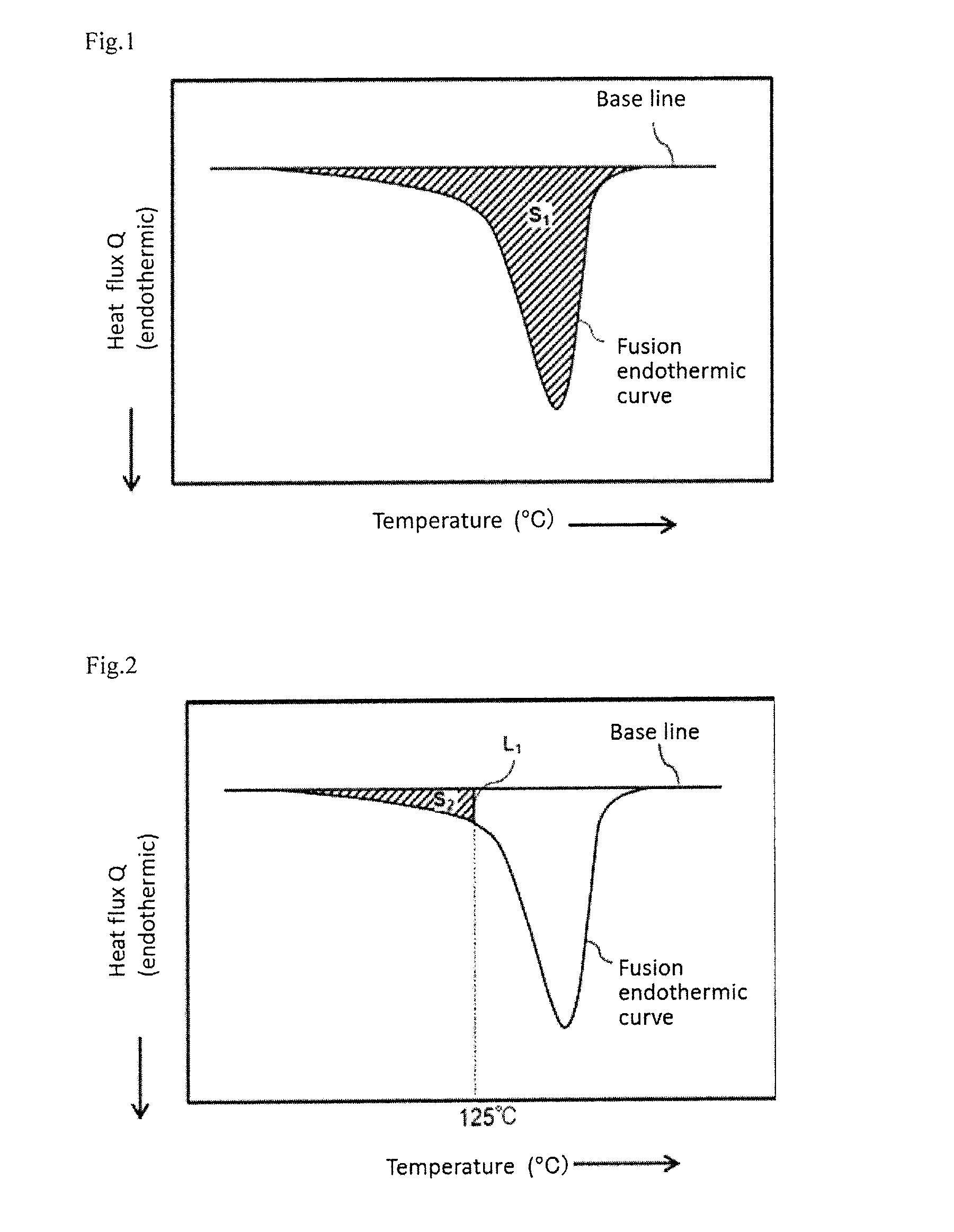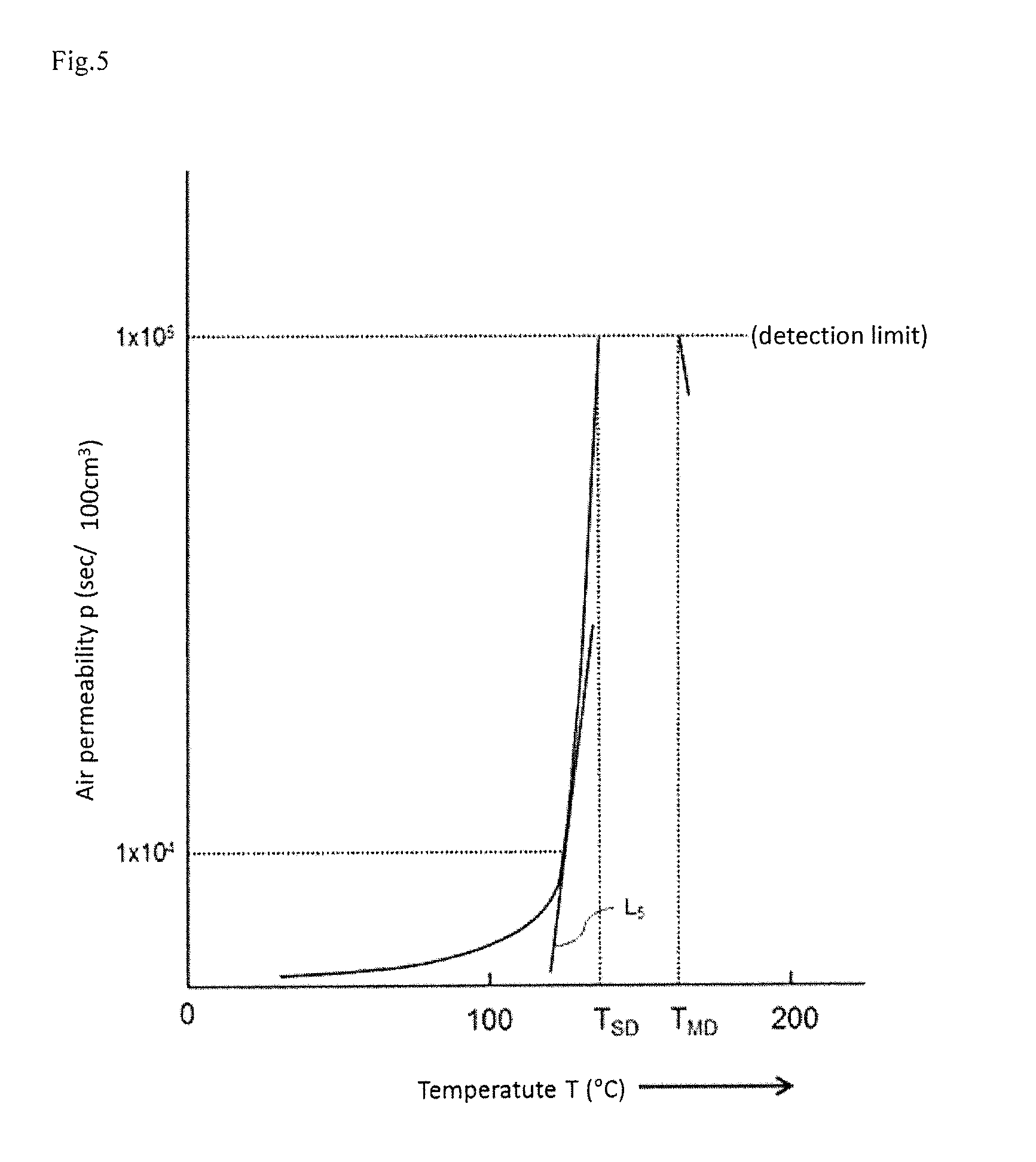Battery separator and method of producing the same
a battery separator and separator technology, applied in the field of battery separators, can solve the problems of abnormal heat generation in the battery, internal short circuit, and high energy density, and achieve excellent shutdown properties, physical strength, and heat resistance.
- Summary
- Abstract
- Description
- Claims
- Application Information
AI Technical Summary
Benefits of technology
Problems solved by technology
Method used
Image
Examples
example 1
Polyolefin Microporous Membrane
[0136]One hundred parts by mass of a polyethylene (PE) composition comprising 30% by mass of an ultra-high molecular weight polyethylene (UHMWPE) having a mass average molecular weight (Mw) of 2.5×106 and 70% by mass of a high density polyethylene (HDPE) having a Mw of 2.8×105 was dry-blended with 0.375 parts by mass of tetrakis[methylene-3-(3,5-ditertiarybutyl-4-hydroxyphenyl)-propionate]methane to obtain a mixture.
[0137]The Mws of UHMWPE and HDPE were determined by gel permeation chromatography (GPC) under the following conditions, and so on.
[0138]Measuring apparatus: GPC-150C available from Waters Corporation
[0139]Column: “Shodex” (registered trademark) UT806M available from Showa Denko K.K.
[0140]Column Temperature: 135° C.
[0141]Solvent (mobile phase): o-dichlorobenzene
[0142]Solvent flow rate: 1.0 mL / min
[0143]Sample Concentration: 0.1% by mass (dissolution conditions: 135° C. / h)
[0144]Injection amount: 500 μL
[0145]Detector: Differential refractometer...
example 2
Polyolefin Microporous Membrane
[0151]Similarly to Example 1, the polyolefin microporous membrane (a) was used.
Preparation of Coating Solution
[0152]To 1.0 parts by mass of CMC, product No. 2200, (available from Daicel Finechem Ltd.), 50.0 parts by mass of a solvent was added and stirred for 2 hours. Subsequently, 49.0 parts by mass of alumina fine particles of substantially spherical shape having an average diameter of 0.5 μm were added and stirred for 2 hours to thoroughly disperse the alumina fine particles. The resulting mixture was then microfiltered through a polypropylene felt filter with a filtering particle size (initial filtration efficiency: 95%) of 10 μm to prepare a coating solution (B). At this time, the volume ratio of the resin component to the fine particles was 5:95.
Lamination of Modifying Porous Layer
[0153]The coating solution (B) was applied to the polyolefin microporous membrane (a) in the same manner as in Example 1 and dried to produce a battery separator.
example 3
Polyolefin Microporous Membrane
[0154]Similarly to Example 1, the polyolefin microporous membrane (a) was used.
Preparation of Coating Solution
[0155]To 1.2 parts by mass of CMC, product No. 2200, (available from Daicel Finechem Ltd.), 41.2 parts by mass of a solvent was added and stirred for 2 hours. Subsequently, 57.6 parts by mass of alumina fine particles of substantially spherical shape having an average diameter of 0.5 μm were added and stirred for 2 hours to thoroughly disperse the alumina fine particles. The resulting mixture was then microfiltered through a polypropylene felt filter with a filtering particle size (initial filtration efficiency: 95%) of 10 μm to prepare a coating solution (C). At this time, the volume ratio of the resin component to the fine particles was 5:95.
Lamination of Modifying Porous Layer
[0156]The coating solution (C) was applied to the polyolefin microporous membrane (a) in the same manner as in Example 1 and dried to produce a battery separator.
PUM
| Property | Measurement | Unit |
|---|---|---|
| Temperature | aaaaa | aaaaa |
| Temperature | aaaaa | aaaaa |
| Temperature | aaaaa | aaaaa |
Abstract
Description
Claims
Application Information
 Login to View More
Login to View More - R&D
- Intellectual Property
- Life Sciences
- Materials
- Tech Scout
- Unparalleled Data Quality
- Higher Quality Content
- 60% Fewer Hallucinations
Browse by: Latest US Patents, China's latest patents, Technical Efficacy Thesaurus, Application Domain, Technology Topic, Popular Technical Reports.
© 2025 PatSnap. All rights reserved.Legal|Privacy policy|Modern Slavery Act Transparency Statement|Sitemap|About US| Contact US: help@patsnap.com



